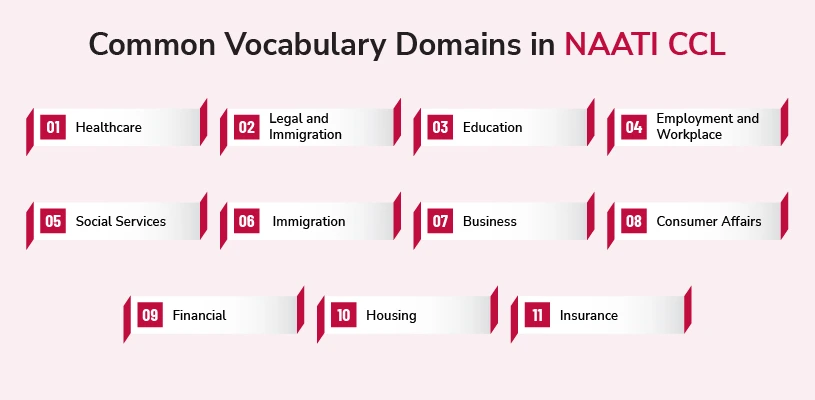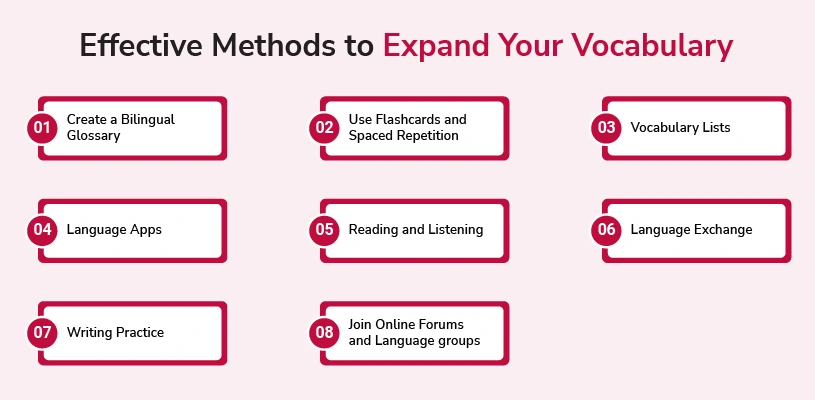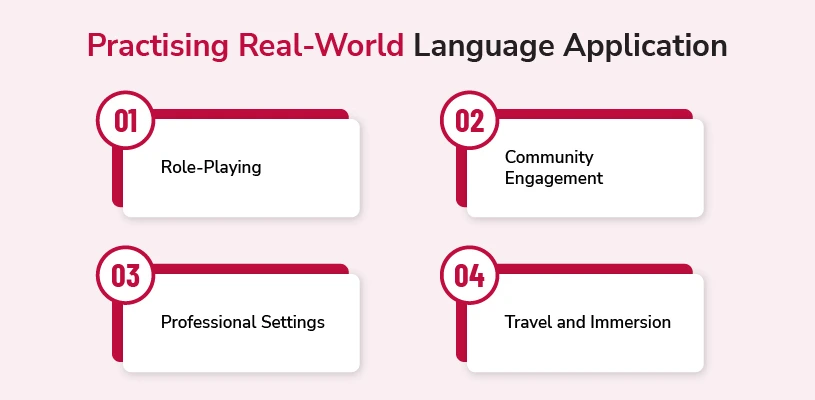
How to Improve Your Bilingual Vocabulary for NAATI CCL?
The NAATI Credentialed Community Language (CCL) test is an essential stepping stone for individuals aiming to claim additional points (5 points) for their Australian PR application. This test assesses your ability to interpret and translate between English and your native language in real-life community settings.
While mastering grammar and fluency is vital, expanding your bilingual vocabulary is the key to excelling in the exam. A broad vocabulary ensures that you can interpret dialogues naturally and accurately without hesitating or struggling for the right words.
If you’re preparing for the NAATI CCL, this guide will help you identify key vocabulary domains, learn effective vocabulary-building methods, and apply real-world language skills to ace the test with confidence.
In this blog, we will explore various strategies to improve your bilingual vocabulary specifically tailored for the NAATI CCL test. We will delve into identifying key vocabulary domains, effective methods to expand your vocabulary, practicing real-world language application, utilising past NAATI CCL test dialogues, and overcoming common challenges.
By the end of this blog, you will have a comprehensive understanding of how to enhance your bilingual vocabulary and increase your chances of success in the NAATI CCL test.
Identifying Key Vocabulary Domains
Before diving into vocabulary building, it’s essential to understand the structure of the NAATI CCL test. The test consists of two dialogues, each lasting about 300 words, covering everyday community topics.
These topics range from healthcare and legal issues to social services and business. Therefore, your vocabulary should be well-rounded and cover a broad spectrum of domains.
Common Vocabulary Domains in NAATI CCL

1. Healthcare
This domain includes terms related to medical conditions, treatments, medications, and healthcare services. For example, words like “prescription,” “symptoms,” “diagnosis,” and “appointment” are commonly used.
- Symptoms (fever, dizziness, nausea, etc.)
- Medical procedures (X-ray, vaccination, surgery, etc.)
- Health services (Medicare, General Practitioner, specialist, etc.)
- Emergencies (ambulance, first aid, CPR, etc.)
2. Legal and Immigration
Legal vocabulary involves terms related to laws, regulations, legal procedures, and rights. Words like “contract,” “witness,” “court,” and “verdict” are essential.
- Legal terminology (contract, affidavit, warrant, etc.)
- Visa types (permanent residency, bridging visa, work permit, etc.)
- Court-related terms (magistrate, plaintiff, defendant, etc.)
3. Education
This domain involves terms related to schools, universities, courses, and academic procedures. Words like “enrolment,” “curriculum,” “scholarship,” and “graduation” are important.
- School levels (primary, secondary, higher education, etc.)
- Subjects and courses (mathematics, science, humanities, etc.)
- Student services (enrollment, scholarship, tuition fees, etc.)
4. Employment and Workplace
- Employment types (full-time, part-time, casual, etc.)
- Workplace policies (leave, payroll, tax deductions, etc.)
- Interview terms (resume, job application, references, etc.)
5. Social Services
This domain covers terms related to community services, welfare, and support systems. Words like “benefits,” “eligibility,” “counseling,” and “housing” are frequently used.
- Welfare programs (Centrelink, pension, disability support, etc.)
- Housing (rent, lease agreement, property insurance, etc.)
- Family services (childcare, domestic violence, counselling, etc.)
6. Immigration
This includes terms related to visas, residency, citizenship, and immigration procedures. Words like “visa,” “passport,” “application,” and “permanent residency” are crucial.
7. Business
- Entrepreneurship, startups, investment, revenue, contracts
- Business meetings, negotiations, corporate policies
8. Consumer Affairs
- Consumer rights, complaints, refunds, warranties
- Product safety, scams, advertisements
9. Financial
- Banking, loans, interest rates, taxes
- Credit scores, budgeting, financial planning
10. Housing
- Renting, leasing agreements, mortgages, real estate
- Landlord-tenant laws, housing applications, public housing
11. Insurance
- Health insurance, car insurance, home insurance
- Claims, premiums, policies, coverage
Understanding these key vocabulary domains will ensure you are well-equipped for a wide range of topics in the NAATI CCL test.
How to Identify Key Vocabulary?
1. Review Past Test Dialogues
One of the best ways to identify key vocabulary is by reviewing past NAATI CCL test dialogues. This will give you a clear idea of the type of vocabulary that is commonly tested.
2. Use NAATI CCL Preparation Materials
There are various preparation materials available that focus on the vocabulary needed for the test. These materials often categorise vocabulary by domain, making it easier to study.
3. Engage with Community Resources
Engaging with community resources such as newspapers, magazines, and online forums in both languages can help you identify relevant vocabulary.
4. Consult Bilingual Dictionaries
Bilingual dictionaries specific to the domains mentioned above can be a valuable resource for identifying key terms.
Effective Methods to Expand Your Vocabulary

Building a strong bilingual vocabulary requires consistent practice and effective strategies. Here are some proven techniques:
1. Create a Bilingual Glossary
Maintain a personal vocabulary journal where you list words, their meanings, and their equivalents in both English and your native language. Categorise words based on the key domains mentioned earlier to make retrieval easier.
2. Use Flashcards and Spaced Repetition
Flashcards are a tried-and-true method for vocabulary building. They are portable, easy to use, and can be customised to suit your needs. Here’s how to use flashcards effectively:
- Create bilingual flashcards: Write the word in one language on one side and its translation on the other. This helps reinforce your memory of both languages.
- Use Spaced Repetition: Review your flashcards regularly, increasing the interval between reviews as you become more familiar with the words.
- Categorise by Domain: Organise your flashcards by vocabulary domains (e.g., healthcare, legal) to make it easier to study specific areas.
3. Vocabulary Lists
Creating vocabulary lists is another effective method. Here’s how to do it:
- Categorise by Domain: As with flashcards, organise your vocabulary lists by domain. This helps you focus on specific areas that are relevant to the NAATI CCL test.
- Include example sentences: For each word, include an example sentence to understand its context and usage.
- Regular Review: Regularly review and update your vocabulary lists to ensure you retain the words.
4. Language Apps
There are numerous language learning apps available that can help you expand your vocabulary. Some popular ones include:
- Duolingo offers vocabulary exercises in various languages.
- Memorisation focuses on vocabulary building through spaced repetition and interactive exercises.
- Anki: A flashcard app that uses spaced repetition to help you memorise vocabulary.
5. Reading and Listening
Engaging with content in both languages is crucial for vocabulary expansion. Here’s how to do it effectively:
- Read Bilingual Books: Reading books that are available in both languages can help you understand how words are used in different contexts.
- Listen to Podcasts and Audiobooks: Listening to content in both languages can improve your listening skills and expose you to new vocabulary.
- Watch movies and TV shows: Watching content in both languages with subtitles can help you learn new words and phrases.
6. Language Exchange
Participating in language exchange programmes can be highly beneficial. Here’s how:
- Find a Language Partner: Connect with someone who speaks the language you’re learning and is learning your native language. You can practice speaking and listening with each other.
- Practice Regularly: Regular practice with a language partner can help reinforce your vocabulary and improve your fluency.
7. Writing Practice
Writing in both languages can help reinforce your vocabulary. Here’s how to do it:
- Keep a Journal: Write daily entries in both languages, focusing on using new vocabulary.
- Write Essays: Write essays on topics related to the NAATI CCL test domains. This will help you practice using domain-specific vocabulary.
- Get Feedback: Have a native speaker review your writing and provide feedback on your vocabulary usage.
8. Join Online Forums and Language Groups
Platforms like Facebook groups, Reddit, and Discord communities dedicated to NAATI CCL preparation provide valuable discussions, shared resources, and practice opportunities.
Practising Real-World Language Application

Memorising words alone won’t guarantee fluency; applying vocabulary in real-life scenarios is crucial. Here’s how you can do it:
1. Role-Playing
Role-playing is an excellent way to practice real-world language application. Here’s how to do it:
- Simulate NAATI CCL Dialogues: Create dialogues based on past NAATI CCL test topics and practice interpreting them with a partner.
- Focus on Vocabulary Usage: Pay attention to how vocabulary is used in different contexts and practice using new words in your role-plays.
- Record and Review: Record your role-plays and review them to identify areas for improvement.
2. Community Engagement
Engaging with the community in both languages can provide real-world practice. Here’s how:
- Volunteer: Volunteer in community organisations where you can use both languages. This will give you practical experience and expose you to new vocabulary.
- Attend Cultural Events: Attend cultural events and festivals where you can interact with native speakers and practice your language skills.
- Join Language Clubs: Join language clubs or meetups where you can practice speaking and listening with others.
3. Professional Settings
If possible, use both languages in professional settings. Here’s how:
- Work in a Bilingual Environment: If your job allows, work in an environment where both languages are used. This will give you daily practice and exposure to professional vocabulary.
- Attend Workshops and Seminars: Attend workshops and seminars conducted in both languages to improve your professional vocabulary.
4. Travel and Immersion
If you have the opportunity, travel to a country where the language is spoken. Here’s how it can help:
- Immerse Yourself: Immersing yourself in the language and culture can significantly improve your vocabulary and fluency.
- Practice Daily: Use the language daily in real-world situations, such as ordering food, asking for directions, and shopping.
- Learn Local Slang and Idioms: Exposure to local slang and idioms can enhance your understanding of the language and make your vocabulary more natural.
Utilising Past NAATI CCL Test Dialogues

1. Analyzing Past Dialogues
Analyzing past NAATI CCL test dialogues is one of the most effective ways to prepare. Here’s how to do it:
- Identify Common Themes: Look for common themes and topics in past dialogues. This will help you focus your vocabulary study on relevant areas.
- Highlight Key Vocabulary: Identify and highlight key vocabulary used in the dialogues. Create flashcards or vocabulary lists for these words.
- Understand Context: Pay attention to how vocabulary is used in context. This will help you understand the nuances of word usage.
2. Practising with Past Dialogues
Practising with past dialogues can help you get a feel for the test format and improve your interpreting skills. Here’s how:
- Simulate Test Conditions: Practice interpreting past dialogues under test conditions. Time yourself and try to interpret the dialogues as accurately as possible.
- Focus on Accuracy: Pay attention to the accuracy of your interpretations. Make sure you are conveying the intended meaning without errors.
- Review and Improve: After practicing, review your interpretations and identify areas for improvement. Focus on vocabulary, grammar, and fluency.
3. Creating Your Dialogues
Creating your dialogues based on past test topics can be a valuable exercise. Here’s how:
- Choose Relevant Topics: Choose topics that are commonly tested in the NAATI CCL test, such as healthcare, legal issues, and social services.
- Incorporate key vocabulary: Use key vocabulary from past dialogues in your dialogues. This will help reinforce your memory of these words.
- Practice Interpreting: Practice interpreting your dialogues with a partner. This will help you get used to interpreting in real time.
4. Break Down Each Dialogue
For every past test dialogue:
- Underline unfamiliar words and find their meanings.
- Practice translating difficult phrases.
- Record yourself interpreting and comparing with sample responses.
5. Mock Test Simulations
Simulating the real test environment will help with time management, confidence, and fluency. Use online resources or form study groups for timed practice sessions.
Common Challenges and How to Overcome Them?

Even with diligent preparation, learners often face challenges. Here’s how to tackle them:
1. Limited Vocabulary
One of the most common challenges is having a limited vocabulary. Here’s how to overcome it:
- Consistent Study: Make vocabulary study a daily habit. Set aside time each day to learn new words and review old ones.
- Use Multiple Resources: Use a variety of resources, such as flashcards, vocabulary lists, language apps, and reading materials, to expand your vocabulary.
- Focus on High-Frequency Words: Prioritise learning high-frequency words that are commonly used in the NAATI CCL test.
2. Difficulty Retaining Vocabulary
Retaining vocabulary can be challenging, especially when learning two languages. Here’s how to improve retention:
- Use Spaced Repetition: Use spaced repetition techniques to review vocabulary at increasing intervals. This helps reinforce your memory.
- Practice Regularly: Regular practice is key to retaining vocabulary. Use new words in speaking, writing, and listening exercises.
- Create Associations: Create associations between new words and things you already know. This can help you remember them more easily.
3. Lack of Confidence
Lack of confidence can hinder your performance in the NAATI CCL test. Here’s how to build confidence:
- Practice Regularly: The more you practice, the more confident you will become. Regular practice will help you feel more comfortable with the language.
- Seek Feedback: Get feedback from native speakers or language tutors. Constructive feedback can help you identify areas for improvement and build confidence.
- Celebrate Progress: Celebrate your progress, no matter how small. Recognising your achievements can boost your confidence and motivation.
4. Time Management
Time management is crucial in the NAATI CCL test. Here’s how to improve it:
- Practice Under Timed Conditions: Practice interpreting dialogues under timed conditions to get used to the time pressure.
- Prioritise Key Vocabulary: Focus on learning key vocabulary that is likely to appear in the test. This will help you interpret more efficiently.
- Develop a Strategy: Develop a strategy for managing your time during the test. For example, allocate specific time for each dialogue and stick to it.
5. Understanding Nuances
Understanding the nuances of both languages can be challenging. Here’s how to improve:
- Study Idioms and Expressions: Learn common idioms and expressions in both languages. This will help you understand the nuances of word usage.
- Practice with Native Speakers: Practice speaking and listening with native speakers to better understand language issues.
- Use Context Clues: Pay attention to context clues in dialogues to understand the intended meaning of words and phrases.
6. Forgetting Words Under Pressure
- Regular revision using spaced repetition to reinforce memory.
- Use context clues to infer meaning instead of panicking.
7. Difficulty with Pronunciation and Accent
- Shadowing technique (repeating after native speakers) to improve pronunciation.
- Listening to bilingual news sources to hear words in context.
8. Struggling with Formal and Informal Language Differences
- Learn to differentiate between casual, semi-formal, and formal tones by studying dialogues in multiple contexts.
9. Managing Test Anxiety
- Take mock tests regularly to build confidence.
- Practice deep breathing and relaxation techniques before the test.
Conclusion
Expanding your bilingual vocabulary for the NAATI CCL test is not just about memorising words—it’s about understanding, applying, and practicing in real-world contexts.
By focusing on key vocabulary domains, using effective learning methods, engaging in active practice, and learning from past dialogues, you can build a strong foundation for success.
Start integrating these strategies today, and you’ll find yourself improving rapidly, making the NAATI CCL test a much smoother experience. Remember, consistent practice and exposure to both languages are key to building a robust bilingual vocabulary. Use a variety of resources, engage with the community, and seek feedback to continuously improve.
With dedication and the right strategies, you can achieve your goal of excelling in the NAATI CCL test and gaining those valuable five points for your Australian permanent residency application.
FAQs
1. How to prepare for NAATI CCL?
To prepare for the NAATI CCL (Credentialed Community Language) test effectively:
- Understand the Test Format: The test consists of two dialogues (English ⇄ LOTE – Language Other Than English), each carrying 45 marks.
- Practice Regularly: Listen to sample dialogues and practice interpreting accurately and fluently.
- Improve vocabulary: Focus on legal, medical, educational, and community-related terms.
- Take mock tests: Simulate the real test environment by practicing with NAATI CCL sample tests.
- Enrol in Coaching: Consider professional NAATI CCL training to enhance your skills.
2. How do I get 5 points from NAATI?
To claim 5 points for Australian PR through NAATI:
- Pass the NAATI CCL Test in your nominated language.
- Obtain the Credentialed Community Language (CCL) certificate from NAATI.
- Submit your result as part of your SkillSelect Expression of Interest (EOI) for General Skilled Migration (GSM) visas.
3. How difficult is NAATI CCL?
The NAATI CCL test is considered moderately difficult, depending on your proficiency in English and LOTE. Key challenges include:
- Accuracy and Fluency: You must interpret without omitting or distorting meaning.
- Vocabulary: Requires familiarity with domain-specific terms.
- Time pressure: Responses need to be quick and precise.
However, with proper practice, many candidates pass on their first attempt.
4. What is the fail rate for the NAATI exam?
The failure rate varies, but on average, about 30–40% of candidates do not pass the NAATI CCL test. The most common reasons for failure include:
- Misinterpretation or loss of meaning.
- Lack of fluency or hesitation.
- Exceeding the allowed number of errors.
5. How many years is NAATI valid for?
A NAATI CCL result is valid for 3 years from the date of issue. You must ensure your result is still valid when submitting your PR application.
6. How long does it take to prepare for CCL?
Preparation time varies based on language proficiency.
- Beginners: 2-3 months of consistent practice.
- Intermediate Learners: 1-2 months with regular practice and mock tests.
- Fluent Speakers: 2-4 weeks of test-specific preparation.
A structured study plan with daily practice can help in faster preparation.



